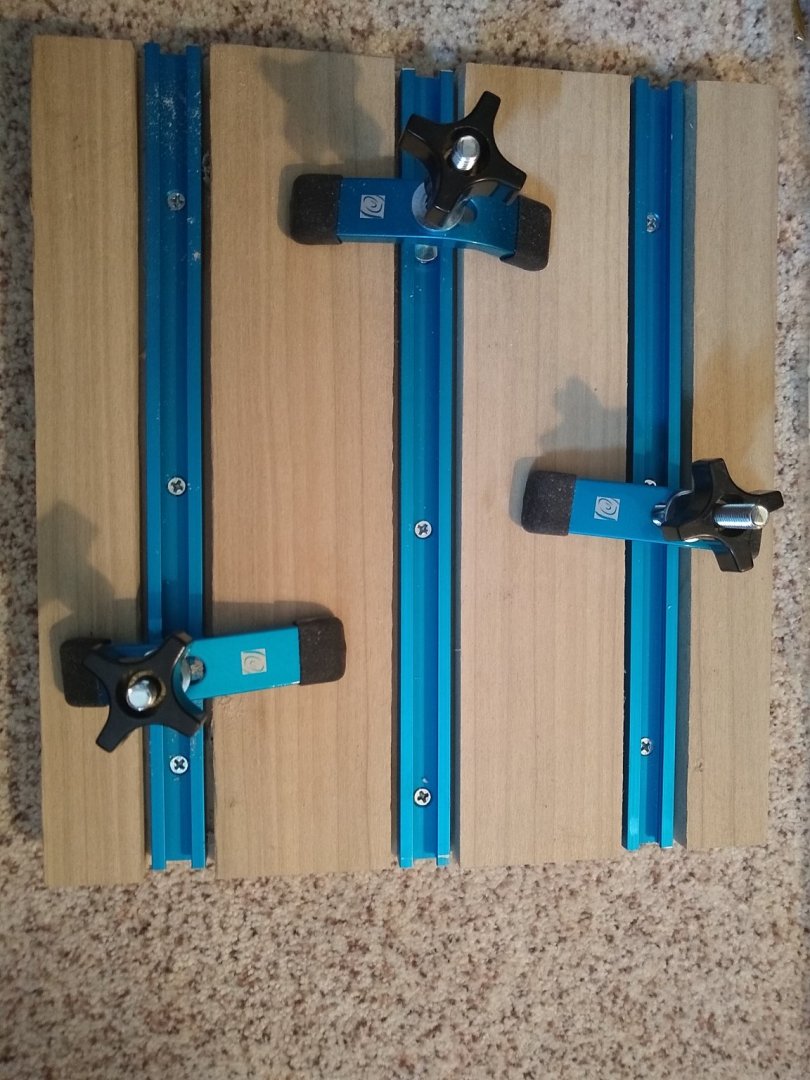-
Posts
1,185 -
Joined
-
Last visited
Content Type
Profiles
Forums
Gallery
Events
Everything posted by CPDDET
-
I finished some of the smaller parts for the aft end of the ship. Namely the boom crutch, quarter bits, small grate that goes on the starboard side of the wheel house and the "unidentified" object which goes on the port side of the wheel house. I decided to dress the "unidentified" object a bit by placing a brass band around the base. I haven't installed these because I still need to to deal with the boom sheet buffer and didnt want to black my access. The britannia metal part supplied with the kit looks awful. The plans show the actual buffer in detail. But one view shows the buffer mounted to the deck while the side view shows it on some sort of platform. Anyway, I'm still contemplating on just how to build this piece. I doubt that I can create it in all the detail shown in the drawing but I have to make something better than the britannia metal piece that came with the kit. This may take some time .........
- 389 replies
-
- bluenose
- model shipways
-
(and 1 more)
Tagged with:
-
Almost! The kerf is the same width as the blade, .012 inches. Actually made to cut dowles flush and very flexible. Makes very fine cut. I have 2 Japanese pull saws as I only use hand tools for my build. https://www.suizan.net/products/suizan-japanese-flush-cut-trim-saw-5-inch-hand-saw-for-hardwood-and-softwood
-
Not sure if this would be of any help with your figurehead but the Smithsonian recently published and article on recovered 19th century figureheads: https://www.smithsonianmag.com/smart-news/rescued-rot-19th-century-naval-figureheads-feature-new-exhibit-180974396/?utm_source=facebook.com&utm_medium=socialmedia&fbclid=IwAR3Xwdz4XWr6EiFYfQAbAG6Rm6OlvDjYvA6suzChH6Dx3u4xaK76Cs-H0pg
-
Ingenious!
-
Thanks, Schooners. The idea of using brass belaying pins for hand holds seemed to come out of nowhere.
- 389 replies
-
- bluenose
- model shipways
-
(and 1 more)
Tagged with:
-
Seems I have a lot to learn about planes. I'm curious, what are the "legs" or standoffs bolted to the sides of the plane in the pictures?
-
Thanks Richard. I loved the challenge, even when my first 2 tries failed. Took me a bit to reach a doable method.
- 389 replies
-
- bluenose
- model shipways
-
(and 1 more)
Tagged with:
-
Thanks, Fright. It's not as perfect as I would have liked but I'm pleased with it.
- 389 replies
-
- bluenose
- model shipways
-
(and 1 more)
Tagged with:
-
You're welcome to it, but there may be easier ways. I'm still a beginner at this.
- 389 replies
-
- bluenose
- model shipways
-
(and 1 more)
Tagged with:
-
I'd love to know more about that plane you're using
-
This took a bit of time but I really wanted to build my own wheel for my model. After a few failed attempts the following worked pretty well. I started with 3 pieces of 1/32 inch basswood. Drew the outside diameter on the first piece with a compass and divided the circle into 6 parts. Cut the square into 6 pieces Reassembled the 6 pieces, spacing the 1/32 inch apart, and glued them to the second square. I thought I would have to shave off 1/64 inch from the edge of each piece to keep the correct diameter with the spacing but it seems the hand saw kerf took care of that. Using my pin vice I drilled a 1/16 inch hole through a small piece of 3/16 inch dowel for the center hub. I drilled a 3/16 hole in the center of the 6 pieces and inserted the hub. Then, using the 1/32 inch gaps as a guide, I drilled 1/32 inch holes through the hub with a pin vice. Using a compass circle cutter I cut the “wheel” from the square. Placed small pieces of 1/32 inch brass rod into the groove and into the center hub holes. Tacked these in place with CA. Using the compass circle cutter I cut another “wheel” from the third piece and glued this on top with wood glue. Clamped and let dry overnight. Cut down 6 brass belaying pins and glued then into the six, 1/32 inch square openings for handles. Did some final sanding, staining and mounted it to the wheel house.
- 389 replies
-
- bluenose
- model shipways
-
(and 1 more)
Tagged with:
-
Are these custom made tools? Standard tools adapted to a new purpose? Specialty tools made for this application?
-
Making nice progress! I understand your tearing out the original deck. After planking the hull on my Bluenose I tore out about 25% of it and re- installed. Dave
- 29 replies
-
- spray
- BlueJacket Shipcrafters
-
(and 2 more)
Tagged with:
-
So true, Richard. Not sure I can build a wooden ships wheel from scratch with hand tools but I'm looking forward to trying. Why do things the easy way when you learn so much more going the long route. Be safe and stay healthy! Dave
- 389 replies
-
- bluenose
- model shipways
-
(and 1 more)
Tagged with:
About us
Modelshipworld - Advancing Ship Modeling through Research
SSL Secured
Your security is important for us so this Website is SSL-Secured
NRG Mailing Address
Nautical Research Guild
237 South Lincoln Street
Westmont IL, 60559-1917
Model Ship World ® and the MSW logo are Registered Trademarks, and belong to the Nautical Research Guild (United States Patent and Trademark Office: No. 6,929,264 & No. 6,929,274, registered Dec. 20, 2022)
Helpful Links
About the NRG
If you enjoy building ship models that are historically accurate as well as beautiful, then The Nautical Research Guild (NRG) is just right for you.
The Guild is a non-profit educational organization whose mission is to “Advance Ship Modeling Through Research”. We provide support to our members in their efforts to raise the quality of their model ships.
The Nautical Research Guild has published our world-renowned quarterly magazine, The Nautical Research Journal, since 1955. The pages of the Journal are full of articles by accomplished ship modelers who show you how they create those exquisite details on their models, and by maritime historians who show you the correct details to build. The Journal is available in both print and digital editions. Go to the NRG web site (www.thenrg.org) to download a complimentary digital copy of the Journal. The NRG also publishes plan sets, books and compilations of back issues of the Journal and the former Ships in Scale and Model Ship Builder magazines.




